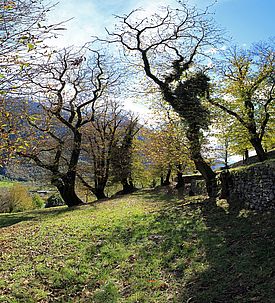29.04.2020 | HEPIA/HESSO | News WSL
It is little known that Switzerland harbours chestnut forests and mixed stands covering about 24000 ha. Even more unknown is that these forests hide a precious genetic resource specific to Switzerland and not existing elsewhere in Europe. This is what an international team of scientists with participation of the Swiss Federal Institute for Forest, Snow and Landscape Research WSL has discovered.
For environmental and historical reasons, most of these still existing forests are located in the Swiss Southern Alps, whereas in the northern parts of the country, chestnut cultivation and related knowledge strongly regressed since the Little Ice Age period.
Nevertheless, as shown in an article published in the international scientific journal Biodiversity and Conservation, Switzerland still hosts valuable genetic resources of the sweet chestnut tree Castanea sativa Mill. The published genetic study bases on a nationwide inventory, conducted in the frame of the "National Plan of Action for Conservation and Sustainable Utilisation of Plant Genetic Resources for Food and Agriculture" (PAN-RPGAA) of the Swiss Confederation.
This intense and long-lasting collaboration involved scientists from several Swiss regions (Swiss Federal Institute for Forest, Snow and Landscape Research WSL and EcoControl in Ticino: HEPIA and In Situ Vivo in Geneva; Swiss Federal Institute of Technology ETH Zurich and MOGLI solutions in Baden), along with colleagues from the University of Santiago de Compostela in Spain and INRA Bordeaux in France.
This huge inventory included identification and precise localisation throughout Switzerland of 14 165 old and/or grafted chestnut trees for conservation purposes. The main objectives of these works were to evaluate the genetic diversity and the genetic structure of the species in Switzerland and to define a program of conservation including the proposal of a core collection.
A pre-selection of 962 accessions was genetically profiled with 24 microsatellites markers, which allowed identifying 675 different genotypes, with a 29.8% of repetitiveness due to clonality. A structural analysis distinguished two main clusters, one mostly related to the genetic group from southern Europe and a second one, which revealed to be independent and genetically different from other European groups of chestnut cultivars.
This later group represents a new genetic group, exclusive to Switzerland and consequently a complement to genetic resources of chestnut tree in Europe. Finally, the researchers defined a core collection of 46 genotypes, which should be used in priority for the Swiss conservation program.
Contact ¶
Publications ¶
Copyright ¶
WSL and SLF provide the artwork for imaging of press articles relating to this media release for free. Transferring and saving the images in image databases and saving of images by third parties is not allowed.



